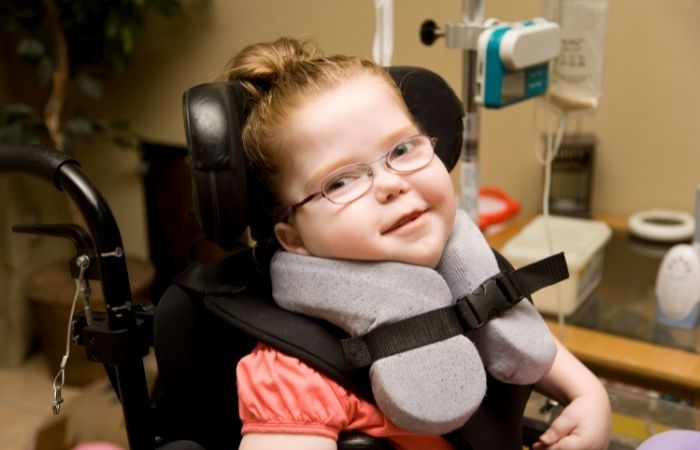Cerebral palsy is a health condition that affects movement and posture. It can occur in the womb, shortly after birth, or in early childhood. This blog post will help you learn the signs of cerebral palsy in the womb and its causes. If you have any worries regarding your kid’s development, see your doctor.
What Is Cerebral Palsy?

Cerebral palsy is a condition characterized by abnormal movement and muscular tone. It is caused by an accident to the brain, which typically occurs before or during birth. The condition can be mild to severe, with varying degrees of impairment across different parts of the body.
People with cerebral palsy often have difficulty with coordination and balance, and they may also experience problems with speech, vision, and hearing. There is no particular cure, but there are a variety of treatments available that can help people manage the condition. With early intervention and proper care, people with cerebral palsy can lead fulfilling and productive lives.
What Shows That a Baby Has Cerebral Palsy Before Birth?
A few signs of cerebral palsy in the womb include:
- Lack of Movement in the Womb: Babies with cerebral palsy often have reduced movement in the womb. Lack of movement is detected in an ultrasound.
- Abnormal Fetal Positioning: Babies with this condition are often positioned abnormally in the womb. It can be detected through an ultrasound.
- Abnormal Brain Development: Such babies often have abnormal brain development that can be detected on an MRI.
What Causes Cerebral Palsy?
There are a variety of factors that can contribute to the development of cerebral palsy, including:
- Genetic Factors: Some people are born with a genetic predisposition to cerebral palsy.
- Infections: Infections during pregnancy, such as toxoplasmosis or cytomegalovirus, can increase the risk of cerebral palsy.
- Brain Injuries: Brain injuries sustained during birth or shortly after birth can lead to cerebral palsy.
- Premature Birth: Premature babies are at a higher risk for cerebral palsy.
Diagnosis of Cerebral Palsy During Pregnancy
The most common tests used for diagnosing cerebral palsy are ultrasound and MRI. An ultrasound can show if a baby has reduced movement in the womb or abnormal fetal positioning.
An MRI can show abnormal brain development. Your doctor may perform other tests, such as a CT scan or EEG, to rule out other conditions. Early intervention is essential for people with cerebral palsy, so getting a diagnosis as soon as possible is essential.
How To Prepare for a Child with Cerebral Palsy?
If you are pregnant and have been diagnosed with the condition, you can do a few things to prepare for your child’s birth.
- Educate Yourself: Learn as much as you can about the condition. This will help you be better prepared to care for your child.
- Find a Support Group: There are many support groups available for parents of children with cerebral palsy. This is an excellent resource for information and support.
- Create a Birth Plan: Work with your doctor to create a birth plan that will be best for you and your child.
Treatment for Cerebral Palsy
There is no cure for this disease, but there are a variety of treatments available that can help people manage the condition. Treatment options include:
- Physical Therapy: Physical therapy can help children with this condition improve their motor skills and lessen their physical limitations. It is one of the most vital treatments, as it can help children develop the strength, coordination, and flexibility needed to move their bodies in new ways.
- Occupational Therapy: Occupational therapy can help children enhance their fine motor skills and learn how to perform everyday tasks. OT can also help children develop social skills and cope with the emotional challenges of living with a disability.
- Speech Therapy: Speech therapy can help children improve their communication skills. Speech therapists can also help children learn how to eat and drink and use assistive devices such as communication boards.
- Medications: There are a variety of medications that can help people manage their symptoms. Medications can treat pain, muscle spasms, seizures, and other conditions associated with CP.
- Surgery: In some cases, surgery may be recommended to treat children. Surgery can be used to correct skeletal deformities, release tight muscles, and improve joint function.
- Assistive Devices: A variety of assistive devices are available to help people live more independently. These devices include wheelchairs, walkers, and communication aids.
Cerebral palsy is a condition that can be difficult to manage, but with the proper support and treatment, people with this condition can lead whole and fulfilling lives. If you or someone you know has been diagnosed with CP, many resources are available for guidance, and several people are willing to help you through this journey.
Hey welcome to my blog . I am a modern women who love to share any tips on lifestyle, health, travel. Hope you join me in this journey!

Speak Your Mind